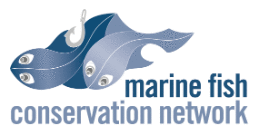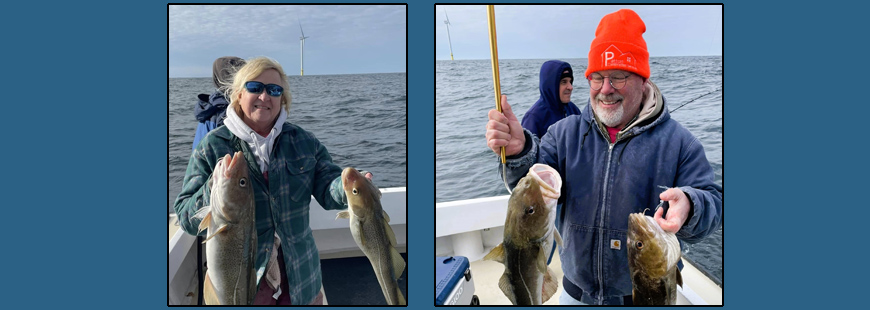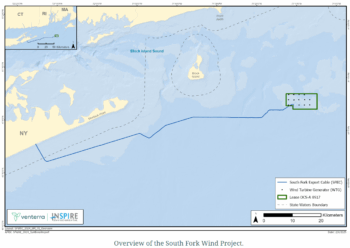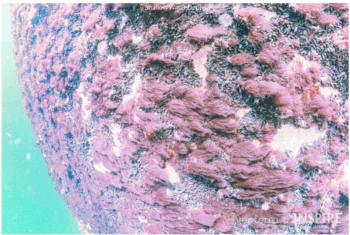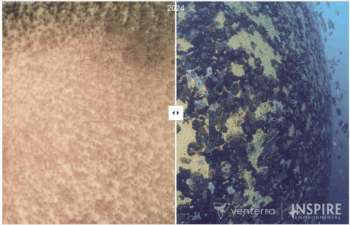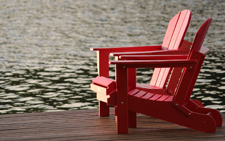Top photo: Fishing Machine Charters, Pt. Judith, RI hooked up with cod, pollock and cunner in the Cox Ledge area wind farm this winter.
A visual survey conducted at South Fork Wind (SFW), an offshore wind farm located 16.5 nautical miles southeast of Block Island, Rhode Island in the Cox Ledge area, shows that the project has had minimal environmental impact on the surrounding marine ecosystem and has created a positive “reef effect.”
Similar “reef effects” have been documented by peer reviewed studies at European wind farms and during a seven-year study at the Block Island Wind Farm, which showed there was a greater amount of Atlantic cod and black sea bass in the wind farm area compared to two control areas outside the wind farm, and all other species abundance was even.
Simply put, so far at 18 months out, South Fork Wind is yielding new habitat and fish.
James Riggs, a recreational fishing representative on the Fisheries Advisory Board (FAB) of the Rhode Island Coastal Resources Management Council (CRMC), said, “The enhanced ecology that I clearly see will only compound with time and become more and more prolific. It gives me hope that we can see a real benefit from what is already structurally out there, and will be for a long time. There may be opportunities to enhance or improve on existing and or proposed marine infrastructure projects.”
Key findings of the study include no detectable changes to the biological communities on the seafloor surrounding the turbines; marine life is using the wind turbine foundations as habitat; and the project is already creating a reef effect, providing habitat for commercially, recreationally, and ecologically important marine species.
The 12-turbine wind farm has the first American-built offshore wind substation made in Texas with export cables made in South Carolina. Quite frankly this nation did a poor job of gearing up for offshore wind; initially we had little or no capability to build components or provide ships needed to do the job, so this is encouraging.
South Fork Wind’s comprehensive benthic (seafloor) monitoring program includes target visual studies at pre-construction, construction and post- construction time periods, which is something that fishermen advocated for. Comprehensive monitoring, like this study, is a requirement and aims to protect valuable marine resources and habitat.
To meet this requirement, independent science teams have conducted extensive visual monitoring surveys of the wind farm pylons, scour protection at the base of pylons, and cabling and bolder relocation areas.
Pictures speak louder than words
The good news is that SFW benthic surveys have not detected demonstrable change in the biological community or benthic functions associated with pylons, cable routes or bolder relocation. Striking video and still images taken before, during and after construction show extensive blue mussel growth and fish at pylons and in the surrounding area. See videos and still images at South Fork Wind Benthic Monitoring Program.
“I was very surprised with the mussel growth on pylons that has occurred so quickly. The video footage clearly showed the creation of life on the pylons and at the base of the pylons on the scour protection,” said Fred Mattera, executive director of the Commercial Fisheries Center of Rhode Island, which represents nine commercial fishing-related organizations in Rhode Island.
Wind farms add new structure to the marine environment that marine invertebrates attach to and grow on. The new habitat and availability of food resources brings shellfish to the area attracting small and large fish.
As a charter captain, I have spent twenty years putting customers on structure, such as reefs, jetties, channel banks, and bridge abutments, to catch fish. Structure has been proven to enhance fishing because it creates habitat for sea life and fish, and it serves to create water movement, tossing around small fish so larger fish can prey on them for dinner.
Mattera said, “These structures are creating new habitat and life. The amount and variety of fish captured on video footage is incredible.”
This summer and winter there were numerous fishing reports from charter captains and anglers catching tuna, cod and an abundance of mahi-mahi at South Fork Wind.
“Simply put, my position is neither for or against offshore wind development, but if there is a way to improve marine habitat and strive for the goal of fish abundance I am all for it. I will do my best to advocate for recreational fishermen’s interests whenever I can,” said James Riggs of the FAB.
The South Fork Wind benthic visual surveys document the reef effect and reveal numerous commercially, recreationally and ecologically important species. Black sea bass, lobster, and flounder were documented near the structures. Other species observed included Atlantic cod, scup, cunner, barrel fish, flounder, butterfish, jack, mahi mahi, trigger fish, Bermuda chub, winter and summer flounder, sculpin, spotted and red hake, ocean pout and the Atlantic rock/Jonah crabs.
South Fork Wind has a comprehensive research and monitoring plan in place. Other studies being conducted as part of the plan include gillnet and fish pot surveys, a ventless trap survey, a beam trawl survey, mechanical jigging study, and acoustic telemetry studies. Most of these studies are still underway. Visit the Commercial Fisheries Research Foundation at South Fork Wind Farm Fisheries Monitoring — CFRF and an article on the Marine Fish Conservation Network blog for details on the South Fork Wind research and monitoring plan.
